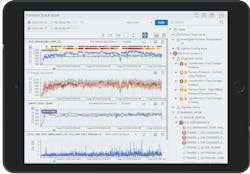The business impact of condition-based monitoring
With traditional maintenance and safety strategies, most calls tend to be either reactive or part of a scheduled maintenance. But both of these are expensive and unnecessary.
Reactive calls are often the most expensive and disruptive, especially when an asset has already broken, and the facility must be shut down. More problems than would be expected are caused by mistakes in maintenance and safety procedures.
Standard scheduled maintenance can be a wasteful practice for two reasons. First, the maintained device often does not require maintenance, making scheduled maintenance a wasted operational practice. Second, failure catalysts are often introduced into properly working equipment, and devices often fail immediately after they are maintained. To better control costs, process manufacturers have started an aggressive campaign to minimize such operations by focusing on condition-based monitoring to significantly improve both availability and reliability.
What is condition-based monitoring?
Condition-based monitoring (CBM) is a type of predictive maintenance combination of software and services that involves using sensors to measure the status of an asset over time while it is in operation. The data collected can be used to establish trends, predict equipment or process failures, and calculate the remaining life of an asset. CBM solutions can create alerts and share data for use in workflows, dashboards and reports.
When you use software to help you with CBM, you are employing digital twin algorithms that address the core issues inherent in condition-based monitoring. The algorithms look at differences between current behavior of a process and the past behavior of a process combined with historical past behavior. This is likely to show very subtle deviations in performance.
Algorithms need to make sense of the information coming out of the core monitoring. The reconstructed state — which is all the information from each of the sensors that are monitored — is called an estimate or an estimate vector. The estimate represents the good or the expected behavior of the asset considering the context to the data captured. That is then compared to the behavior of the asset as it actually occurs at a given point in time. The difference between the two signals is then analyzed by sophisticated statistical algorithms to detect departures from normality.
It is not just the algorithm itself that makes CBM a reality. It is all the supporting machinery, the additional algorithms that make sense of the output from the core machine learning algorithm and, sometimes most importantly, the expertise in analyzing the output to make recommendations for next steps.
When CBM is able to proactively spot problems, maintenance labor costs can be reduced by moving unplanned maintenance to planned, decreasing the amount of time a maintenance procedure takes and extending the intervals between maintenance procedures.
The second leg of decreased maintenance costs is represented by less spending to repair or replace parts that are damaged. Though this type of benefit may appear negligible, the process industry can save as much from fuel reduction and running its equipment more efficiently as it can from maintenance cost savings.
How does it work?
Every piece of equipment is unique as reflected in its own historical data. You will be able to find digital twin “blueprints” that can be the foundation of your CBM solution. But you also need to know what to look for and what do with the information:
Anomaly detection: Anomaly detection models contextualize normal operating relationships among all relevant parameters, such as load, temperatures, pressures, vibration readings and ambient conditions. Real-time analytics compare sensor readings to a particular machine’s normal, predicted values. CBM software detects and identifies events and abnormal behavior by the differences between real-time actual data and predicted, normal behavior — not by thresholds on actual values.
Diagnostic analysis: Anomaly notifications are compared with precursor signatures based upon pattern and persistence. These provide prioritized diagnostics with a localized, apparent cause for each developing problem. For all problems identified, you should be notified quickly so reliability and maintenance experts can track and diagnose the developing failures.
Time-to-action forecasting: Next, time-to-action analytics can be applied to the analysis process. Using multiple analytics and desired time windows, engineers can forecast when the equipment will actually reach an alarm limit and require immediate remediation. With this intelligence, teams can prioritize and schedule corrective actions to avoid downtime at minimal cost. Time-to-action analysis can also be applied independently at any point to forecast future maintenance needs.
Adopting a digital solution solves some traditional limitations of equipment maintenance. Digital solutions help to centralize data collection and equipment health views, and provide predictive analytics and policies, as well as analytics to modernize how work gets done and, last but not least, deliver an automated and trackable process.
More about the benefits
By moving to a proactive, data-driven operations strategy, process manufacturers can expect up to a 40% decrease in spend associated with unplanned maintenance. This leads to decreased production losses across all industries — megawatts in power, barrels of oil in oil and gas processing, and natural materials for metals and mining companies.
One oil and gas company was challenged by a $4 million loss each day from production stoppages. If any asset in the operation fails, even a small component, all production stops, which becomes very costly, very quickly. Through CBM, the company was not only able to cut down reporting of issues from 1.5 hours to less than five minutes, it was also able to realize 16 days of early warning of a critical failure and address the problem before the failure occurred.
Leading companies can improve operations, optimize reliability and increase availability with today’s predictive technologies. They can also improve availability and reliability because they can detect impending problems in time to act proactively before the problems impact operations.
Effective predictive maintenance centers on advanced analytics to predict, diagnose and forecast future issues. Digital twins used for CBM provide automated surveillance to discover developing issues, diagnostic guidance for causal analysis and actions and time-to-action forecasting intelligence to ensure that remediation is scheduled prior to any failure.
Software provides visualization, analysis and case management tools, coupled with analytics intelligence that reliability and maintenance engineers can use to investigate alerts, perform root cause analysis, determine immediate and long-term maintenance strategies and track ultimate success.
Another positive for CBM is that it can extend the life of an asset. In addition to improving reliability, collected data can help to maintain a unified view of asset state and operational health.
The bottom line is this: CBM allows processors to reduce maintenance costs, grow revenue and accelerate return on equity.
Thomas Lowisz is the product manager for GE Digital’s APM Reliability and SmartSignal products, driving the vision, strategy and product roadmap investments. With over 13 years of experience in predictive analytics, he has worked with customers across the power generation, oil and gas, mining and metals, and aviation industries. He graduated from the Milwaukee School of Engineering with a bachelor’s degree in mechanical engineering.
GE Digital
About the Author
Thomas Lowisz
Senior product manager at GE Digital
Based in Chicago Illinois, Thomas Lowisz is the Product Manager for GE Digital’s APM Reliability and SmartSignal products, driving the vision, strategy and product roadmap investments. With over 13 years of experience in the predictive analytics space, he has worked with customers across the power generation, oil & gas, mining & metals, and aviation industries. Starting his career with SmartSignal who was later acquired by GE, Thomas worked in the original SmartSignal “monitoring and diagnostic center” which provides asset monitoring services for customers. His role included active monitoring of analytics and weekly calls with plant managers/reliability groups to investigate findings and provide recommendations on mitigating actions. Later Thomas moved to the United Kingdom working hands on at customer facilities implementing software, helping customers improve their data and scaling their asset coverage. Thomas graduated from Milwaukee School of Engineering with a bachelor’s degree in mechanical engineering.

